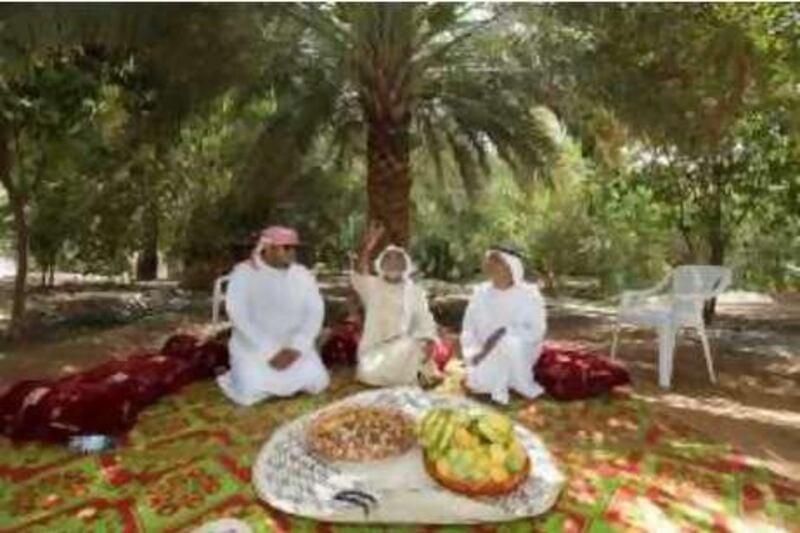AL AIN // Ali bin Saeed ,70, has never owned a pair of sunglasses. His younger cousin Mohammed takes them off indoors; Mohammed's son Ahmed, however, wears them regardless of where he goes. "My eyes are strong and are used to the worst possible seasons here," says Ali, a former soldier whose children number in double figures. "So why do I need a pair of flimsy feminine sunglasses?"
Sitting outside in the family garden under a small forest of palm and mango trees and a kaleidoscope of butterflies, Ali shares a breakfast of coffee, dates and laban with Mohammed, a 52-year-old retired Army brigadier general, and 21-year-old Ahmed. Mangos and banana trees were introduced to the local farms in the 1990s, particularly in Al Ain, and have since become a summer must. "Eating light and dressing light were key to remaining healthy in this season," says Ali, as he pulls out the traditional moqasar he used to wear in the summer. The outfit, a shortened khandura, stops just below his knees, and the sleeves do not reach the elbow.
Instead of black abayas, which only became popular in the 1950s, the women wore colourful cotton thoubs, with broad, butterfly-like sleeves to help keep them stay cool, and light head scarfs - all sewn by the women themselves. "Because we have air conditioning now, we don't need to wear the shortened khandura anymore," says Mohammed, who still remembers the days before electricity. Ahmed, he says, has never worn a moqasar.
"Life is so much easier for us than it was for the older generations," Ahmed says. "I never have to worry about the summer as I can simply travel to cooler countries." The hotter part of the summer, known as al Qaiz, is traditionally associated with myths of the "headless" camels and donkeys - "hemar al qaylah". "Because of mirages, fogs in the early hours and being sunstruck, we would often see strange things during the day and for some reason it was always some headless animal wandering about," Ali recalls.
As a protection, he swore by a henna mix that used to be prepared by the women of the family. The mix was put on the head to keep it cool and reduce headaches from the heat. "It used to have such a nice smell as it was mixed with flowers," he says. The women braided it into their hair, making a sticky mask that was kept for a week before being washed. "We used to bathe fully only once a week as water was scarce," he says. Instead, they used desert sand to wipe off dirt.
The coastal tribes and residents of the islands would move to an oasis such as Al Ain in the summer. There, the falaj irrigation system served as a major water source. The three men's family, the al Neyadi, is one of the major tribes in Al Ain. They helped find and build some of the underwater channels commissioned by Sheikh Zayed, the founding President of the UAE, in the 1950s. Whoever found a water source was paid 500 rupees.
"We were lucky in Al Ain for having water," Ali says. "Those living in the other emirates weren't as lucky and people often died while travelling or trying to find shelter from the heat." Ali and Mohammed both recall painful memories of drought and food shortages around the time of the Second World War and in the years before the UAE was founded. "We would have one meal a day of just a single dish, one day rice only, one day only bread, and some days only bird seeds and wheat," Ali says.
Before the discovery of oil, every bit of the palm tree was used. Dates were an important food source, while the fronds were used as fans and brooms. Desert herbs and shrubs were both medicines and moisturisers. With the spread of electricity in 1970s and the introduction of fans, refrigerators, and eventually air conditioning, life in the summer became more bearable. At the same time, many Emiratis started to travel to Europe, Asia or India for the summer.
"Of course I like the AC and modern benefits," says Ali, "but sometimes, I just like to sit outside in the daytime and reconnect with my past." For exercise, he climbed a palm tree in the middle of the day using a traditional belt of twisted dried fronds for support as he cut off some dried up branches using a curved khanjar, or traditional dagger. Despite the modern mitigations, Mohammed and Ali agreed that summers are getting hotter, and are worse than those of the past.
"It is hotter than before, but there was also far more rain during the summer," says Mohammed. "These days, maybe it is just better to travel than suffer the heat." @Email:rghazal@thenational.ae






